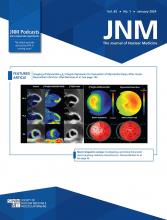TO THE EDITOR: We read with great interest the recent editorial by Graham regarding the progressive staffing shortage experienced by nuclear medicine in the United States (1). As the authors noted, the shortage is associated with inadequate production of well-trained nuclear medicine physicians during the last 2 decades. Interestingly, this workforce problem can be closely linked to a trend in hiring—in both academic programs and the private sector—diagnostic radiologists with minimal nuclear medicine training (1 y) instead of nuclear medicine physicians (1). Consequently, nuclear medicine has been considered a less attractive specialty by medical students, in parallel with a drop in the quality of applicants for nuclear medicine residency.
Notably, in some countries, such as Greece, nuclear medicine is a separate discipline, whereas in other parts of the world, such as the United States, nuclear medicine studies can also be performed by diagnostic radiologists. This heterogeneity has been reinforced by the introduction of hybrid systems (SPECT or PET combined with CT, and PET combined with MRI). Because both nuclear medicine physicians and diagnostic radiologists are involved in the performance of these techniques, a proposed solution was the establishment of joint training programs for hybrid imaging, currently available in only some countries (2).
From our point of view, nuclear medicine should continue as a separate discipline as we enter the era of personalized practice. Undoubtedly, the molecular imaging findings of SPECT or PET represent the most clinically valuable information obtained using hybrid systems. In particular, the functional–pathophysiologic findings of SPECT and PET are based on the principles of molecular imaging, and implementation of these techniques requires training in clinical medicine, as well as a thorough knowledge of radiochemistry (radiopharmacology, medical physics, and radiation protection). In addition, the development of radioactive agents able to diagnose and treat certain types of cancer (theranostics) may lead to crucial advancements in the management of oncology patients. Therefore, the growing field of theranostics applications for nuclear medicine should be prioritized and further supported, given the potential clinical impact on our patients.
At this point, we would like to add some information concerning the training and practice of nuclear medicine in Greece. The Hellenic Society of Nuclear Medicine and Molecular Imaging was founded in 1968, one of the oldest societies of nuclear medicine in Europe. The 5-y curriculum of residency includes training not only in nuclear medicine (33 mo) but also in radiology (9 mo, with a 6-mo internship in a CT unit and 3 mo in ultrasound or MRI studies), internal medicine (12 mo), cardiology (6 mo), or, alternatively, cardiology (4 mo) and oncology, hematology, pediatrics, or endocrinology (2 mo). There are more than 20 centers for residency across the country, including laboratories in university hospitals and departments in public and military hospitals. As far as the practice of nuclear medicine is concerned, the corresponding diagnostic and therapeutic applications can be performed only by nuclear medicine physicians. Particularly for hybrid imaging techniques, an experienced nuclear medicine physician can interpret a PET or SPECT scan combined with low-dose CT (used for localization, attenuation correction, and scatter correction), based on recent changes in state regulations. On the other hand, full diagnostic CT (or MRI) hybrid examinations are interpreted by an experienced nuclear medicine physician in cooperation with an experienced radiologist.
Under the current status of nuclear medicine practice in Greece, the departments of nuclear medicine provide services independently in public hospitals and the private sector. Recently, 4 modern PET/CT scanners were installed in nuclear medicine departments of university hospitals in the peripheral cities of Larissa (Thessaly), Heraklion (Crete), Ioannina (Epirus), and Alexandroupolis (Thrace), and 1 more PET/CT scanner was also installed in the nuclear medicine department of a military hospital, through a grant from the Stavros Niarchos Foundation. In parallel, despite a significant decrease in applications for nuclear medicine residency during the last decade, an increase in the number of residents has been observed recently, reflecting a positive message for the future of our discipline in Greece.
Footnotes
Published online Sep. 14, 2023.
- © 2024 by the Society of Nuclear Medicine and Molecular Imaging.







